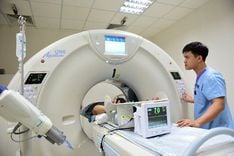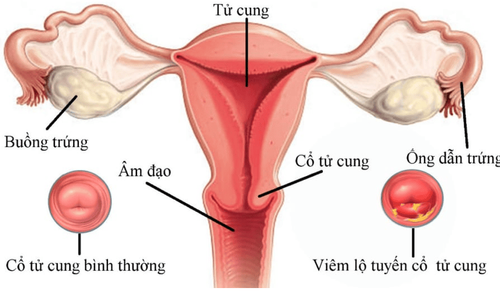This is an automatically translated article.
A pituitary tumor is a tumor that develops from cells of the pituitary gland, located in the pituitary fossa deep inside the skull. There are many treatments for pituitary tumors, in which radiation therapy for malignant pituitary tumors is indicated when the tumor has persisted or re-grows after surgery, causing symptoms that do not respond to treatment. medicine.1. Malignant pituitary tumor
The pituitary gland is a very important endocrine gland located in the pituitary gland deep inside the brain, responsible for many body functions including adrenal function, thyroid gland, bone growth and milk secretion.A pituitary tumor in the brain is a tumor that develops from the cells of the pituitary gland, most of which are benign. However, sometimes pituitary adenomas can also develop into malignant pituitary adenomas when they invade nearby tissues and organs, and more rarely, spread to other organs in the body. Some of the symptoms of pituitary tumors include: pituitary dysfunction such as menstrual irregularities, increased prolactin secretion, growth retardation, acromegaly, fatigue, and infertility. These symptoms can appear even in cases of small tumors. In large cases of pituitary adenoma, it can compress the nerves causing facial numbness and strabismus. Very large pituitary tumors cause increased intracranial pressure, nausea, headache, and coma.
There is no evidence of environmental malignancy. The only risk factor is heredity, including:
Multiple endocrine neoplasia type 1 (MEN1): Family members with MEN1 often have an increased risk of pituitary adenomas. Carney complex: a genetic disorder that can increase the risk of pituitary tumors Acromegaly: is an enlarged extremities and enlargement of peripheral organs such as ears, nose, jaw, ... due to an excess of growth hormone.

U tuyến yến phần lớn là lành tính
2. Radiation therapy for malignant pituitary tumor
There are many treatment methods for pituitary tumors such as surgery, medical treatment, hormone replacement therapy, radiation therapy,... Radiation therapy is one of the methods applied to treat adenomas. and can be used alone or in combination.
Radiation therapy in the treatment of pituitary tumors is to use radiation beams from the outside to penetrate the skin and skull to reach the tumor. When the radiation beams hit the tumor, they destroy the tumor cells by damaging the DNA.
Radiation therapy is indicated to treat residual pituitary tumor and prevent tumor recurrence after surgery. If the tumor cannot be surgically removed or the tumor recurs after surgery, radiation therapy may also be used as a separate treatment.
The process of radiation therapy for patients is performed by experts in many fields including: radiation therapists, radiotherapy technicians, medical physics engineers. Radiotherapy techniques for malignant pituitary tumors include:
Radiosurgery: is a treatment method that allows a high dose of radiation to be delivered to the tumor in a therapeutic dose fraction. Radiosurgery does not include excision or surgery. First, the patient will have a simulated CT scan with suitable immobilizers. After obtaining a series of images, the doctors will proceed to determine, the location and size of the tumor, the adjacent healthy organs to protect. The doctor and physical engineer will devise the most appropriate radiation therapy plan to ensure that the high dose of radiation is focused to the tumor, and the maximum dose is limited to the surrounding healthy organs. Usually, patients with radiation surgery will receive 1 to 5 fractions of treatment.

Điều trị u tuyến yên bằng phương pháp xạ trị
Dose-modulated radiation therapy: applied to large pituitary tumors with extensive invasion into the cavernous sinus, allowing to focus high radiation doses to the tumor and minimize the dose to the muscles. surrounding healthy organs, in order to reduce the side effects caused by radiation. Dose-modulated radiation therapy usually lasts 4 to 6 weeks, and is given 5 days a week. Proton radiation therapy: uses a beam of protons to kill cancer cells, unlike radiosurgery and modulated radiotherapy that use X-ray beams. Proton beams only damage a small part of the tissue in front of the tumor. , the cancer cells of the tumor will receive the maximum amount of energy should be completely destroyed, and most of the healthy tissue behind the tumor is preserved. However, this method requires high equipment and costs, so it is less popular. Patients with radiation therapy often have side effects such as fatigue, skin irritation, or loss of bowel movements, etc. After radiation therapy, most side effects will stop. Depending on the direction of irradiation, patients may experience some complications with vision, temporary loss of consciousness or memory impairment. These side effects are usually rare and do not cause serious problems.
In short, radiation therapy in the treatment of malignant pituitary tumors is to use radiation beams from the outside to penetrate the skin and skull to reach the tumor. Radiation therapy is indicated for cases of recurrence after surgery or long-standing tumors. However, when radiation therapy often has side effects such as headache, fatigue, ... and may experience some complications. Therefore, when the patient shows any abnormal signs, it is necessary to immediately notify the medical staff for timely intervention.
Vinmec International General Hospital is one of the hospitals that not only ensures professional quality with a team of leading medical doctors, modern equipment and technology, but also stands out for its examination and consultation services. comprehensive and professional medical consultation and treatment; civilized, polite, safe and sterile medical examination and treatment space.
Customers can directly go to Vinmec Health System nationwide to visit or contact the hotline HERE for support.













